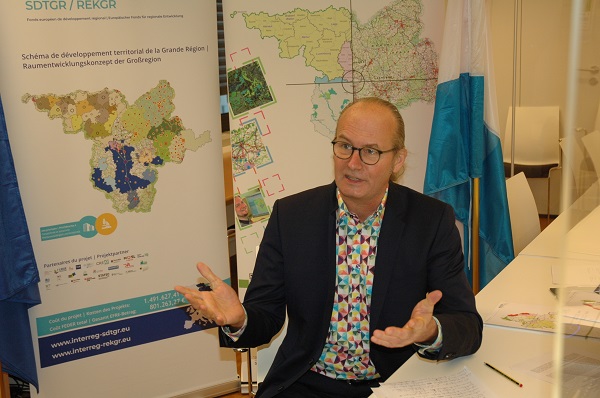 Claude Turmes, Luxembourg's Minister for Spatial Planning;
Credit: MEA, DATer
Claude Turmes, Luxembourg's Minister for Spatial Planning;
Credit: MEA, DATer
On Tuesday 12 January 2021, Luxembourg's Minister for Spatial Planning, Claude Turmes, invited his counterparts from the Greater Region to the 7th sectorial meeting on spatial planning.
The meeting was held via video conference and brought together the following participants: Minister Claude Turmes; Willy Borsus, Vice-President and Minister for Economic Affairs, Foreign Trade, Research and Innovation, the Digital Economy, Agriculture and Spatial Planning of Wallonia; Antonios Antoniadis, Deputy Minister-President and Minister for Health and Social Affairs, Regional Development and Housing of Belgium's German-speaking Community; Nicole Steingaß, Rheinland-Palatinate State Secretary of Ministry of Interior and for Sports; Christian Seel, Saarland State Secretary of the Ministry for Internal Affairs, Construction and Sport; Hervé Vanlaer, regional director for the environment, planning and housing of the Grand Est region; Franck Leroy, Vice-President of the Grand Est region; Patrick Weiten, President of the Moselle Department Council; Valérie Beausert-Leick, President of the Meurthe-et-Moselle Department Council; Stéphane Perrin, Vice-President of the Meuse Department Council.
As a preamble, the participants underlined their attachment to the deep cross-border solidarity shown since the start of the COVID-19 health crisis between the political authorities and the populations of the Greater Region. Minister Claude Turmes said that he was "proud of our partners in the Greater Region who have often helped us with their interventions in Berlin, Paris or Brussels to keep the borders open".
The participants expressed their conviction of the role of spatial planning in supporting, on the one hand, the revival of sustainable socio-economic activity and in developing, on the other hand, a dynamic of shared societal resilience, particularly around questions of health, short circuits and ecological transition.
At their previous meeting on 16 January 2020, the participants agreed that the document "Une vision prospective transfrontalière pour la Grande Région" (a forward-looking cross-border vision for the Greater Region), which was unanimously validated at the meeting and subsequently approved by the intermediate summit of the Greater Region, would give rise to the development of a cross-border operational strategy. Consequently, the participants adopted this document, which has been finalised within the last twelve months, at Tuesday's meeting. The objective of this strategy is to develop axes and actions around flagship projects that make it possible to achieve the goals retained in last January's resolution and thus to respond concretely to long-term challenges by 2040.
Minister Claude Turmes was delighted that "despite the complicated situation due to the health crisis linked to COVID-19, it was possible for us to move within a year to a concrete strategy around four axes": to anticipate, support and guide transitions in order to act on resource management; to improve services and promote the balanced implementation of activities for the benefit of the public; to develop low-carbon and resilient rural and urban areas; to develop together the projects and structures of the territory by involving more members of the public.
Following a call launched in April 2020, the participants welcomed the high number of project ideas submitted. Among the 35 project ideas submitted and included in the strategic document, several are considered promising from a spatial planning point of view and are thus likely to contribute to the achievement of the objectives selected. They will soon be subjected to a more in-depth analysis by sectoral experts outside the field of spatial planning.
Luxembourg's Minister for Spatial Planning explained: "The list now requires an appropriation and an analysis of sectorial experts and is certainly not definitive: the current ideas can be developed and others can be added to them". He emphasised the need to develop concrete projects promoting the efficient management of resources (circular economy, water management, timber industry, etc.) and the improvement of services, particularly public services for the benefit of all, using a low-carbon and resilient approach.
The participants approved a joint resolution for the attention of the executives of the summit of the Greater Region setting out the objectives of their joint approach within the framework of the work of the Interreg A Grande Région project "Schéma de développement territorial de la Grande Région" (SDTGR; territorial development scheme for the Greater Region). They agreed to submit the operational strategy for approval to the Greater Region summit on 20 January 2021.
Knowing that the European Commission requires a strategy for each cooperation territory within the framework of the next Interreg 2021-2027 programming period, this document lends itself to this request in view of the new Interreg Greater Region programme, which should have a budget of over €200 million.
The participants saluted the summit's commitment and support for the creation of the European Cross-Border Mechanism (ECBM) tool currently being developed within the European Union. Capable of removing legal and administrative obstacles in a cross-border context and facilitating cross-border cooperation, the principle of such a tool is considered essential by those responsible for spatial planning.
They also congratulated the "Système d'information géographique de la Grande Région" (SIG-GR; geographical information system of the Greater Region) on its 10th anniversary. Since its creation in 2010, the SIG-GR has become an essential working tool for supporting political decision-making at cross-border level in the Greater Region.








